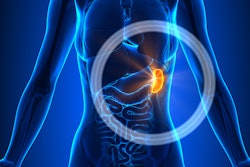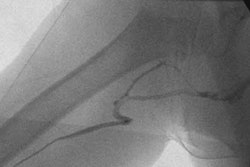Imaging specialists still have a significant hold on percutaneous peripheral arterial interventions, but other physicians are gaining ground in this area. Cardiologists in particular may be horning in on the territory thanks to self-referral, according to a study in the Journal of the American College of Radiology.
Dr. David Levin and colleagues analyzed physician roles in the performance of peripheral arterial interventions from 1997 to 2002. Levin and three of his co-authors, including Dr. Vijay Rao and Laurence Parker, Ph.D., are from Thomas Jefferson University in Philadelphia. Co-investigator Jonathan Sunshine, Ph.D., is from the American College of Radiology in Reston, VA.
For this study the group mined data from the Centers for Medicare and Medicaid Services (CMS) Physician/Supplier Procedure Summary Master Files. All CPT-4 codes pertaining to percutaneous transluminal angioplasty (renal or visceral, iliac, etc.) and noncardiac stent placements were identified. Carotid angioplasty, carotid stent placements, and endovascular stent grafts were not included because codes were unavailable.
Physician specialty codes were grouped as follows:
- Diagnostic radiology, interventional radiology, and nuclear medicine
- Cardiology and peripheral vascular disease specialists
- Vascular surgeons
- Other physicians, including general surgeons, internists, and nephrologists
The results showed that total procedure volume grew by 95% (88,865 to 173,119) between 1997 and 2002. During the five-year period, the radiologists' procedure volume increased by 29% while cardiologists' procedure volume grew by 181%. In 1997, radiologists performed 63.3% of the procedures; by 2002, that figured had dropped to 42%.
However, "it should be noted that ... more than 16,000 new procedures were added by radiologists, and that in 2002, they still performed more of these procedures than any of the other three groups," Levin's group explained. Specifically, radiologists performed 72,657 procedures in 2002 (JACR, January 2005, Vol. 2:1, pp. 39-42).
Despite more rapid growth rates among other specialists, interventional radiologists shouldn't be disheartened as they "continue to have a vital and growing role in the field," the group stated. On the other hand, complacency is not advisable either.
"The growth trend among cardiologists should be of some concern to healthcare payers and policy makers, because cardiologists have the ability to self-refer and to perform 'drive-by' peripheral arterial interventions during the course of cardiac catheterization procedures," the authors warned.
By Shalmali Pal
AuntMinnie.com staff writer
January 26, 2005
Related Reading
ACR to pitch Congress on 'designated physician imagers' for Medicare, January 6, 2005
CMS finalizes coverage for carotid artery stenting, October 13, 2004
Radiologists seek to optimize PICC line placement, July 9, 2004
Copyright © 2005 AuntMinnie.com



















